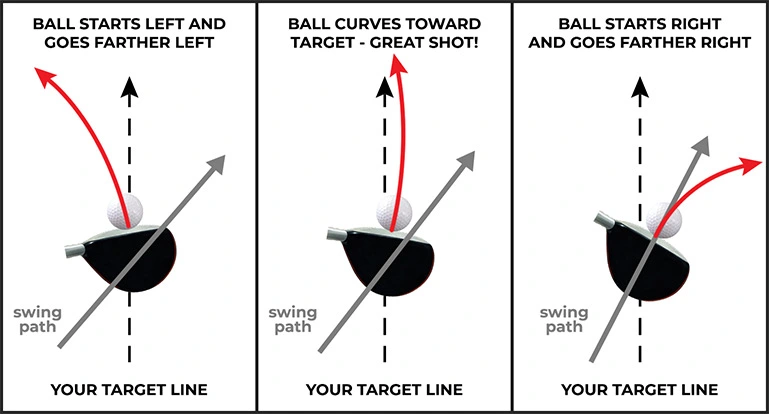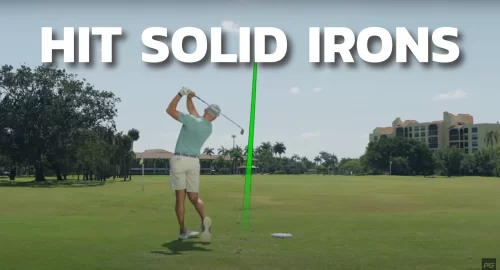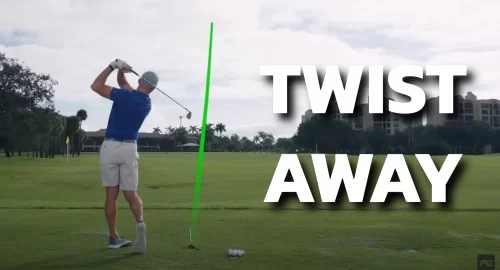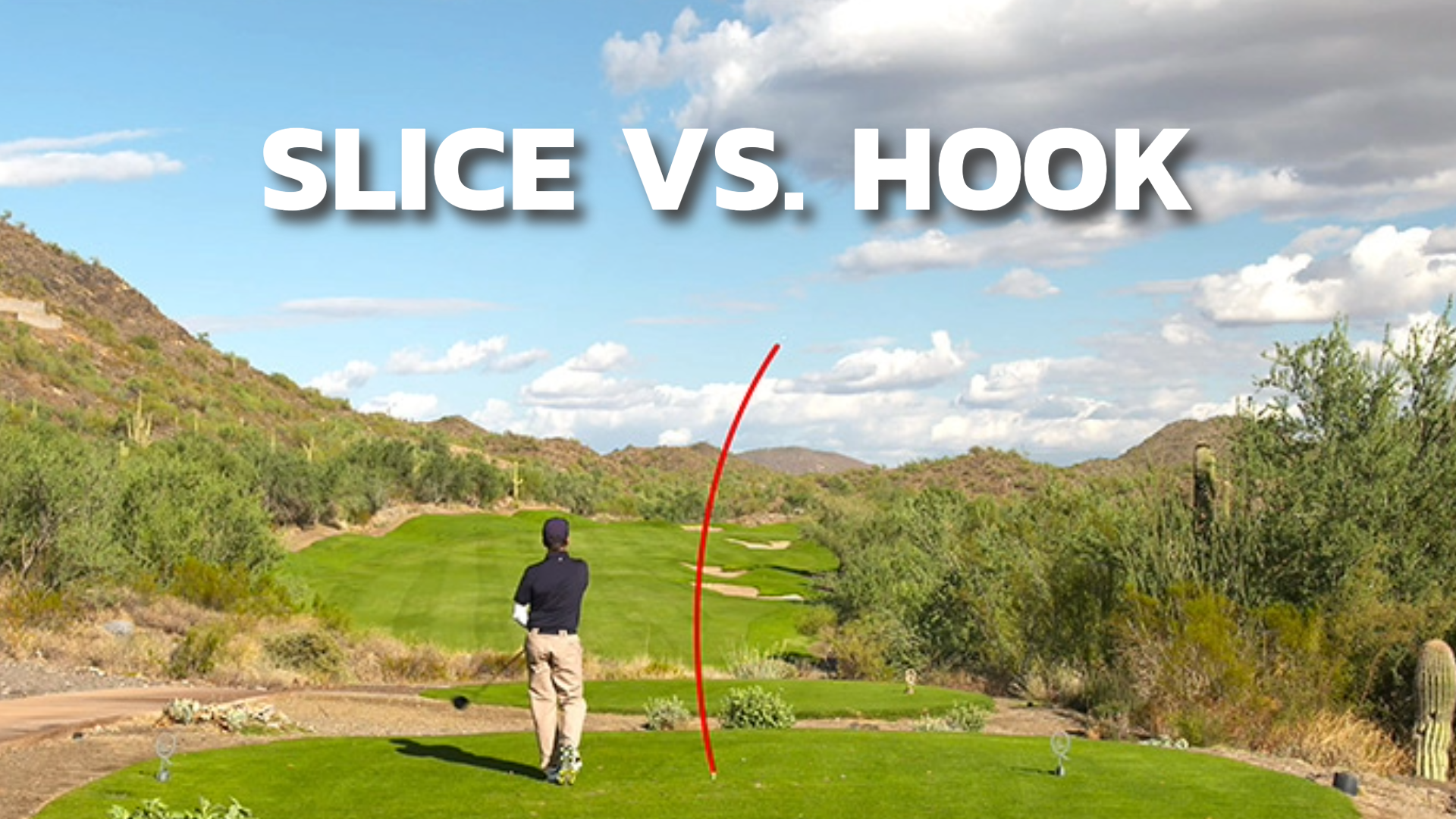
When researching how to improve your golf swing, you’ve probably seen slice and hook (similarly, draw and fade) come up quite a bit. Today we’ll go over the difference between a golf slice vs. hook, and how can you tackle it.
As you know, there are so many golf terms, it’s easy to get intimidated when learning about this great game. A slice is a battle that nearly every golfer has had to overcome, but both shots are equally frustrating.
Today, we’ll review each of these shots by determining the common causes, how to easily fix them, and ultimately how to hit a straight shot every time.
Golf Slice vs. Hook – What’s the Key Difference?
The Dreaded Slice
A slice is arguably the most common shot pattern in golf. This is when the ball drifts from left to the right in the air thanks to an open clubface at impact position (for a right-handed golfer).
Depending on the path, the ball might start left, straight, or right of the target. A ball that starts left and then slices is called a pull slice. While a ball that starts right and slices further right is called a push slice (as shown above).
While none of these shots are ideal, a pull slice is the most “playable.” The ball starts left of the target and then drifts back, which doesn’t end up in as much trouble.
Slices are so frustrating because they limit distance off the tee and make it hard to find fairways. If you can fix your slice, you can add 10, 15, or even 20+ yards to your tee shots. Not to mention play from the short grass, not from behind trees, in fairway bunkers, or worse.
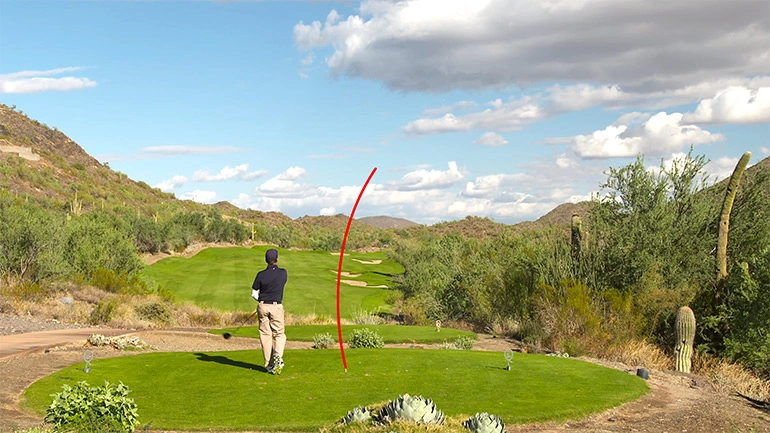
Cause of a Slice
So, why do slices happen? Why do so many golfers suffer from this shot pattern?
One of the most common reasons for a golf slice is a weak grip – specifically a weak left hand for a right-handed golfer, or weak right hand for left-handers. By getting into a neutral position or even a slightly strong position, it’s easier to square the clubhead at impact.
Another common reason for slices is an inside takeaway. When you take the club too far back on an inside path, it leads to a steep, over-the-top downswing and an out-to-inside swing path.
If you need help with your takeaway, make sure to check out the StraightAway. This small, portable training aid from world-class coach David Leadbetter can help you create a “Tour Takeaway” fast, which will lead to straighter, longer drives and well flushed iron shots.
Longer clubs have more of a tendency to slice, specifically the driver. This is why so many golf club manufacturers sell draw-biased drivers. These clubs have different weighting and sometimes offset hosels which make it easier to square the face at impact.
The Fade in Golf
Slices tend to move 10-20 (or more) yards from left to right in the air when hitting a driver. But a fade is a version of this shot that is much more playable and even considered reliable.
A fade is when the face is slightly open at impact and only drifts a few yards. This is a highly coveted shot as it’s very accurate and doesn’t lose out on distance like a slice. We won’t go too much into this shot here, but if you want to read more about draws and fades, click here.
The Hook: Less Common But Still Happens
A hook is a generally a less common shot pattern in golf, but nearly as frustrating as the slice.
This is when the ball drifts from right to left in the air thanks to a closed clubface at impact position (for a right-handed golfer). A hook also has a lot of topspin so when it does hit the ground it keeps rolling, which means it can put you even further out, or worse, lead you to a bunker.
Similar to a slice, the path also dictates the direction of the shot. A ball that starts left and then hooks is called a pull hook, while a ball that starts right and hooks is called a push hook.
If you swing too much from the inside, this will lead to pushing the shot right of the intended target. However, the hook spin will bring it back more toward the target and make it the most playable shot. While a pull hook starts left and keeps going left – this is one you want to avoid at all costs.
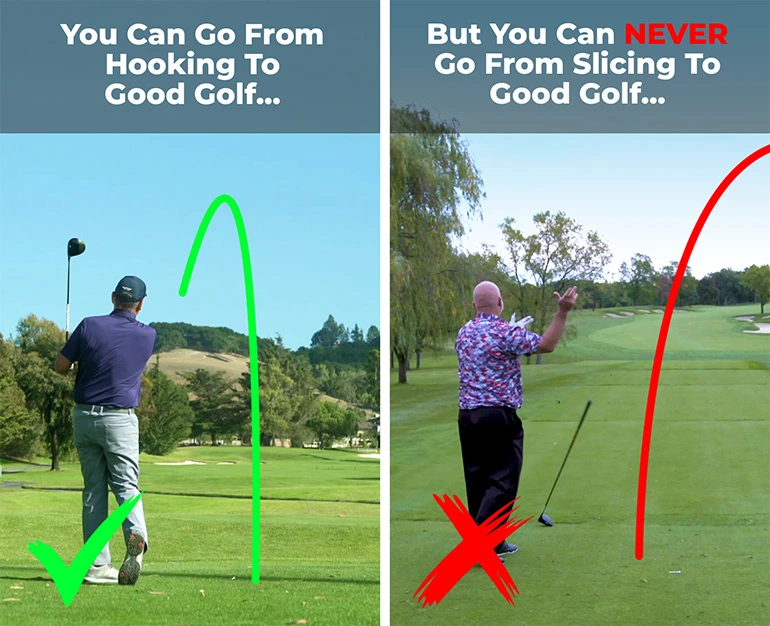
The Underlying Cause of a Hook Shot
So, what causes a hook shot? Pretty much the exact opposite of what causes a slice.
If you’re suffering from a hook, one of the most common reasons is a grip that is too strong. If your lead hand is too much over the grip, it’s easy to shut the face too much at impact. Try to weaken your hand into a more neutral position to straighten out your ball flight.
Another reason hook shots occur is from a takeaway that is too far on an outside plane. This leads to dropping the club too much from the inside and flipping your wrists on the downswing. Alignment too far to the right might be to blame as well.
The Draw
Just like a fade is a more playable version of a slice, the same applies to the draw and hook. Hooks tend to move 10-20 (or more) yards from right to left in the air when hitting a driver, whereas a draw is a better version of this shot where the club is slightly closed at impact.
It’s one of the most sought-after shots in golf, as it goes longer than a fade or straight shot. You’ll need plenty of lag to hit one of the most coveted shots in golf.
“Golf is the closest game to the game we call life. You get bad breaks from good shots, you get good breaks from bad shots – but you have to play the ball where it lies” – Bobby Jones
Getting the Straight Shot
We’ve learned that a slice is an open clubface at impact, while a hook is a closed clubface at impact. But what happens when the clubface is square?
A straight shot – what Tiger Woods once referred to as the hardest shot to hit in golf.
If you’re like most golfers, chances are you don’t hit a straight shot as much as you’d like. It’s hard to time your swing and path correctly, but there isn’t anything quite as satisfying as when you do.
If you need help improving your swing for a more consistent shot pattern, make sure to check out The Straight Stick. This revolutionary swing trainer from Rocco Mediate makes it easy to improve your grip, increase lag, and time your release perfectly.
Fix The Slice Once and For All!
If you’ve been fighting a slice for what seems like your entire golf career, it’s time to change it once and for all. We have two resources that can help you stop slicing once and for all:
One Shot Slice Fix: If you want to keep your same equipment, learn to fix your slice, and add distance, you’ll love this video training from Hank Haney. Yes, the same coach who helped Tiger Woods win six major championships and 31 PGA Tour wins. He makes it easy to learn the “Counter-Slice Sequence” to quickly correct your natural swing in five minutes or less on the driving range.
SF1 Driver: The SF1 driver from Performance Golf is a game-changing club that is built to help straighten out your ball flight. It has anti-slice curvature design to produce draw spin, even if you don’t find the sweet spot.
We hope these tips can help you improve your golf swing, fix your slice, and enjoy this great game of golf!
